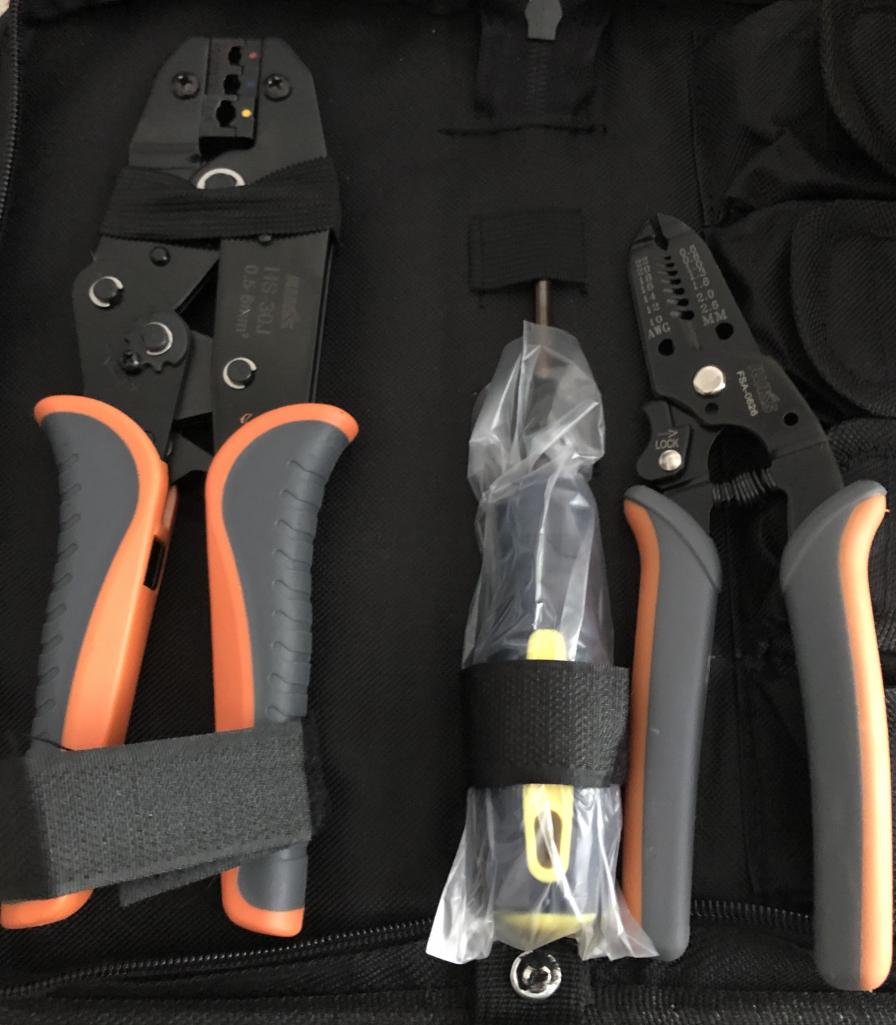|
|

|
Porsche, and the Porsche crest are registered trademarks of Dr. Ing. h.c. F. Porsche AG.
This site is not affiliated with Porsche in any way. Its only purpose is to provide an online forum for car enthusiasts. All other trademarks are property of their respective owners. |
|
|
  |
| ClayPerrine |
 Jan 5 2020, 06:33 AM Jan 5 2020, 06:33 AM
Post
#21
|
|
Life's been good to me so far.....                Group: Admin Posts: 16,526 Joined: 11-September 03 From: Hurst, TX. Member No.: 1,143 Region Association: NineFourteenerVille 
|
Having been professionally trained on alll methods and techniques of soldering, and having repaired thousands of wiring harnesses over the years, I will continue to disagree with you.
The problem with soldering connections is not with the soldering. If you do it right, and don't extend the solder past the end of the metal on the connector, you don't damage the copper strands when you strip the wire, and you put proper strain reliefs on the wire, then you will have a good connection. |
| Tjmrfe |
 Jan 5 2020, 08:34 AM Jan 5 2020, 08:34 AM
Post
#22
|
|
NON IMPEDING RATIONE COGITATIONIS   Group: Members Posts: 132 Joined: 10-April 15 From: Cornwall on Hudson, New York Member No.: 18,612 Region Association: North East States |
Having been professionally trained on alll methods and techniques of soldering, and having repaired thousands of wiring harnesses over the years, I will continue to disagree with you. The problem with soldering connections is not with the soldering. If you do it right, and don't extend the solder past the end of the metal on the connector, you don't damage the copper strands when you strip the wire, and you put proper strain reliefs on the wire, then you will have a good connection. I agree 100% I have been building, repairing and troubleshooting elevators in some of the tallest buildings in Manhattan for the past 33 years, talk about vibration! When done properly, a good solder, is the best form of connection, the reason the aviation industry shuns it is human error is higher and temperatures vary greatly. I have removed wires from 40 years of service in a 50 story building with no soldering issues, due to the well trained men who came before me, mostly Military trained, so done properly, it’s the most effective. |
| gereed75 |
 Jan 5 2020, 08:47 AM Jan 5 2020, 08:47 AM
Post
#23
|
|
Senior Member    Group: Members Posts: 1,412 Joined: 19-March 13 From: Pittsburgh PA Member No.: 15,674 Region Association: North East States 
|
I think You are both right.
For our purposes, well done crimps (using better quality tools and materials) will yield excellent results. Good soldering is a bit harder and more involved skill to master (as implied by Tjmrfe). I reserve it for use on splices and crimp joints where gas tight joints are hard to achieve ( large gauge wires and terminations) And of course proper use of shrink tube for sealing and strain relief. If you can master these basic skills you can build some reliable and good looking wiring. |
| 914forme |
 Jan 5 2020, 08:54 AM Jan 5 2020, 08:54 AM
Post
#24
|
|
Times a wastin', get wrenchin'!     Group: Members Posts: 3,896 Joined: 24-July 04 From: Dayton, Ohio Member No.: 2,388 Region Association: None 
|
@ClayPerrine Clay you are 100% correct, but an amateur going to professional should not be soldering wires into a harness. You have proper training it is 100% effective, key is proper training.
For a guy to go down the street grab some crap solder and soldering iron, and start soldering up a harness. (IMG:style_emoticons/default/headbang.gif) We hav all done dumb things at one time and still might be we are all someone else's Dumb Previous Owner. I have found through many years working many different industries that I can always find someone better than me. And they intern can point to someone better than them. Clay you are 98% better than most of use on this board at what you know and have learned, and I am sure you can point out a few people who are better still. Soldering has it place, but it should be a pro class item. I solder stuff all the time, but it has the proper strain reliefs. I have torn into enough cars to know that you don't give an untrained person a soldering Iron and say fix that. What you end up with is a bunch of crap, and more repairs. If you spend anytime around boats or trailers you learn the average Joe does some pretty stupid stuff. To make the transition from amateur to professional requires the willingness to learn the craft, what ever craft it is, and then constantly learn as the techniques and technologies continue to advance. Then put in the dedicated hours honing to become a master. |
| gereed75 |
 Jan 5 2020, 10:03 AM Jan 5 2020, 10:03 AM
Post
#25
|
|
Senior Member    Group: Members Posts: 1,412 Joined: 19-March 13 From: Pittsburgh PA Member No.: 15,674 Region Association: North East States 
|
Stephen, pretty much what I was trying to say.
I have spent a lot of well intended time making way more trash soldering than I have made crimping - that includes connectors in my kit built airplane where I thought soldering would be “better” Ended up cutting out most of those crappy efforts and honing my crimping skills with good tools, materials, techniques and results. Thank god for planning in service loops. |
| gereed75 |
 Jan 5 2020, 10:41 AM Jan 5 2020, 10:41 AM
Post
#26
|
|
Senior Member    Group: Members Posts: 1,412 Joined: 19-March 13 From: Pittsburgh PA Member No.: 15,674 Region Association: North East States 
|
The thought of service loops got me thinking further -
For me one of the marks that distinguishes amateur from pro wiring is a pros wiring uses only the amount of wire necessary. In other words he has the confidence to cut wires to the perfect length the first time knowing that his termination technique/skill (soldering or crimping) will be right the first time. The result is a tidy looking job with all wires carrying even strain, no loops, S bends or tangled crossovers. That is what I strive for as an amateur and only achieve sometimes. |
| Superhawk996 |
 Jan 5 2020, 11:35 AM Jan 5 2020, 11:35 AM
Post
#27
|
|
914 Guru      Group: Members Posts: 7,614 Joined: 25-August 18 From: Woods of N. Idaho Member No.: 22,428 Region Association: Galt's Gulch 
|
Having been professionally trained on alll methods and techniques of soldering, and having repaired thousands of wiring harnesses over the years, I will continue to disagree with you. The problem with soldering connections is not with the soldering. If you do it right, and don't extend the solder past the end of the metal on the connector, you don't damage the copper strands when you strip the wire, and you put proper strain reliefs on the wire, then you will have a good connection. (IMG:style_emoticons/default/grouphug.gif) That's OK. The beautiful thing is that each of us is free to do as we see fit on our personal vehciles. I have nothing but respect for the you and the vehicles you've built. You do awesome work and I don't mean to imply anything negative about your craftsmanship. It is impressive! Honestly, I'm aligned to what you are saying that if soldering is done PROPERLY there is little risk in automotive applications IF the wire isn't subject to vibration stress. However, the reality is that most people are not competent at soldering. The tools and the techniqes are far more complicated than the tools required for crimping. It takes training and lots of practice to get soldering right. I say that as USAF trained electronics technician. Nicked wiring from improper stripping, seen it. Overheated wires that melt and degrade the wire insulation, seen it. Underheated wires with a blob of solder just basically sticking two wires together in a high resistance joint, seen it. Improperly designed stress relief that is bent too tightly, and creates intermittent connections as wires vibrate, seen it. Too much solder flux and not cleaned leading to corrosion later on, seen it. Not enough flux, seen it. The list of potential soldering flaws goes on and on. But let's at least be factual about this. A proper crimp is superior and this isn't just my personal opinion or a desire to disagree with you personally or any of the other posters in favor of soldering. The fact that crimping is superior is based on unimaginable test hours conducted by NASA, automotive OEM's, and the global aviation industry on vibration tables and wiring harness test rigs that most readers of this forum have never seen. It is not just a personal opinion or old wives tale. "Crimping is an efficient and highly reliable method to assemble and terminate conductors, and typically provides a stronger, more reliable termination method than that achieved by soldering." Excerpted from NASA document. 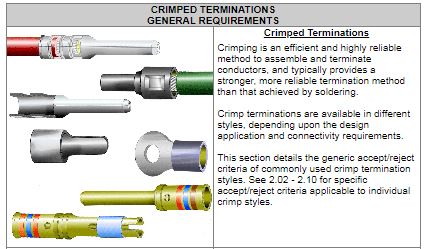 https://workmanship.nasa.gov/lib/insp/2%20b...s/frameset.html See section 2.01 for source of the quote and the graphic. The previous post from @AZBanks on high end motorsports wiring was priceless. Long but incredibly thorough so i won't rehash that one but it was worth reading in full. The craftsmanship & planning that is required to produce F1 level wiring harness is amazing. That truly is what separates professional from amatuer work which was the point of the OP. Here is an example of a medium sized vibration test table. There are tables used that are much larger than this. Now envision that with a complete wiring harness with representative wiring harness attachments and/or instrument panel and other related modules mounted to it and subjected to known road load vibration profiles and duty cycle testing. Sorry I couldn't find one with wiring on it (IMG:style_emoticons/default/sad.gif) https://www.youtube.com/watch?v=etUNYZP_yHA And of course for automotive, 4 post shakers are commonly used by all OEM's for testing and development of full vehicles. Typically 4 posters are not used for durability work like proving out a wiring harness but it gives you some insight into the massive size of some of the vibration test equipment available and the vibration stress that the harness will be subjected to. Here is a neat 7 post shaker being used for suspension development. Skip the first 20 seconds of the nose cone testing. https://www.youtube.com/watch?v=_SPflUyT1rQ |
| Tom |
 Jan 7 2020, 10:43 AM Jan 7 2020, 10:43 AM
Post
#28
|
|
Advanced Member     Group: Members Posts: 2,139 Joined: 21-August 05 From: Port Orchard, WA 98367 Member No.: 4,626 Region Association: None |
Simply put, crimps are better if you don't know what you are doing with solder! This argument will probably go on forever, but my experience says solder is better.
A solder joint is always better electrically and vibration will not be an issue if the harness is routed and supported correctly. Solder weeping up a copper wire is controlled by PROPER soldering techniques. Placing the heat in the right place and using a wire heat sink will prevent solder from creeping up the wire. I was taught to NASA standards in a Naval shipyard and worked to exacting standards on wiring and connectors for nuclear instrumentation on nuclear powered naval ships. I have done a lot of soldering from circuit cards to large power carrying wires. One thing most folks overlook when soldering is cleanliness of the parts to be soldered! Dirty wire and connectors cause bad solder joints. We examined completed solder joints under a microscope for holes due to dirt. If there were holes, solder came off/out and re-cleaned and re-soldered until it passed inspection. Soldered connections remove the chance of corrosion from interfering with the wire to connector connection. There are other ways to help keep corrosion away from the connector to wire joint such as heat shrink connectors using a PROPER crimping tool and heat gun. One area I worked in had a large drawer full of crimpers, in excess of 50, for different size and application. We had engineering provide the type and size of crimper, wire, and connector to use for each connection type. I could go on all day with stories of wiring and connectors and how they interact with the end use and environment they are subjected to in engine rooms. Think of heat, humidity, oils, and vibration. Tom PS: If you are going to do a lot of soldering, do it in a well ventilated area with a fan blowing gently to move the vapors away from you. The lead in solder can cause problems with your health. |
| bandjoey |
 Jan 7 2020, 11:06 AM Jan 7 2020, 11:06 AM
Post
#29
|
|
bandjoey     Group: Members Posts: 4,935 Joined: 26-September 07 From: Bedford Tx Member No.: 8,156 Region Association: Southwest Region |
You all missed the most effective wire connection. Second only to speed tape.
(IMG:style_emoticons/default/beerchug.gif) (IMG:style_emoticons/default/beerchug.gif) Attached image(s) 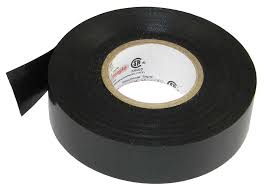
|
| dr914@autoatlanta.com |
 Jan 7 2020, 11:08 AM Jan 7 2020, 11:08 AM
Post
#30
|
|
914 Guru      Group: Members Posts: 8,225 Joined: 3-January 07 From: atlanta georgia Member No.: 7,418 Region Association: None |
original colored wires and sized correctly, solder, and heat shrink tubing. NOTHING less
OK guys - we have some very talented people here and I'm hoping to bring my wiring skills up a level. What separates amateur wiring from a pro level? One item that comes to mind - no use of Harbor Freight connectors (which I am guilt of). What else comes to mind? |
| Tdskip |
 Jan 8 2020, 08:23 AM Jan 8 2020, 08:23 AM
Post
#31
|
|
Advanced Member     Group: Members Posts: 3,748 Joined: 1-December 17 From: soCal Member No.: 21,666 Region Association: None 
|
http://www.visioneng.com/wp-content/upload...rol.15SEP16.pdf I learned a lot from this site. I'm kinda an advanced amateur. ....Soldering should not be used in an automotive strand wire application. Why Not? The crimping examples here make it really clear on why you need a quality crimper. Thanks for sharing this. |
| johnhora |
 Jan 8 2020, 09:45 AM Jan 8 2020, 09:45 AM
Post
#32
|
|
Senior Member    Group: Members Posts: 898 Joined: 7-January 03 From: Derby City KY Member No.: 107 Region Association: None 
|
Thanks to all who have contributed their information on this very interesting topic.
The links to the NASA and RBRacing (and others) sites are certainly illuminating and well worth studying. I've learned a lot....Thanks! |
| johnorm |
 Jan 8 2020, 06:39 PM Jan 8 2020, 06:39 PM
Post
#33
|
|
Newbie  Group: Members Posts: 28 Joined: 28-October 18 From: Canada Member No.: 22,610 Region Association: Canada |
Whether you solder or crimp don't scrimp on the materials. The Chinese wire at the local parts store is not up to surviving in a classic car, especially in the engine bay. For a few dollars more you can buy TXL or GXL wire that's meet many new car specifications.
If you know anyone into the hotrod or classic muscle car scene they are familiar with companies like Painless, American Autowire and Ron Francis. These companies all use quality American made copper strand wire. Their wiring harnesses are typically crimped but solder joints are needed for some applications. For my 914 loom rewire I put the original loom on a 4X8 sheet of plywood. I found a lot of burnt and or hacked up wires / connectors so most if not all of the wires will be replaced (color matched to the original wiring schematic with similar or larger gauge high temp GXL wire) . I'm not that good with wiring, I have done my share of "letting the smoke out", but for most part the 914 loom is made up of crimped wires. For some of the more complicated sub looms, like the FI/engine loom, I will buy a quality pre-made loom. I plan to test each circuit on my work board before it goes in the car. There is many great "wiring" threads on this forum. You can learn a lot from those guys, regular and pro's, who have been through this before us. 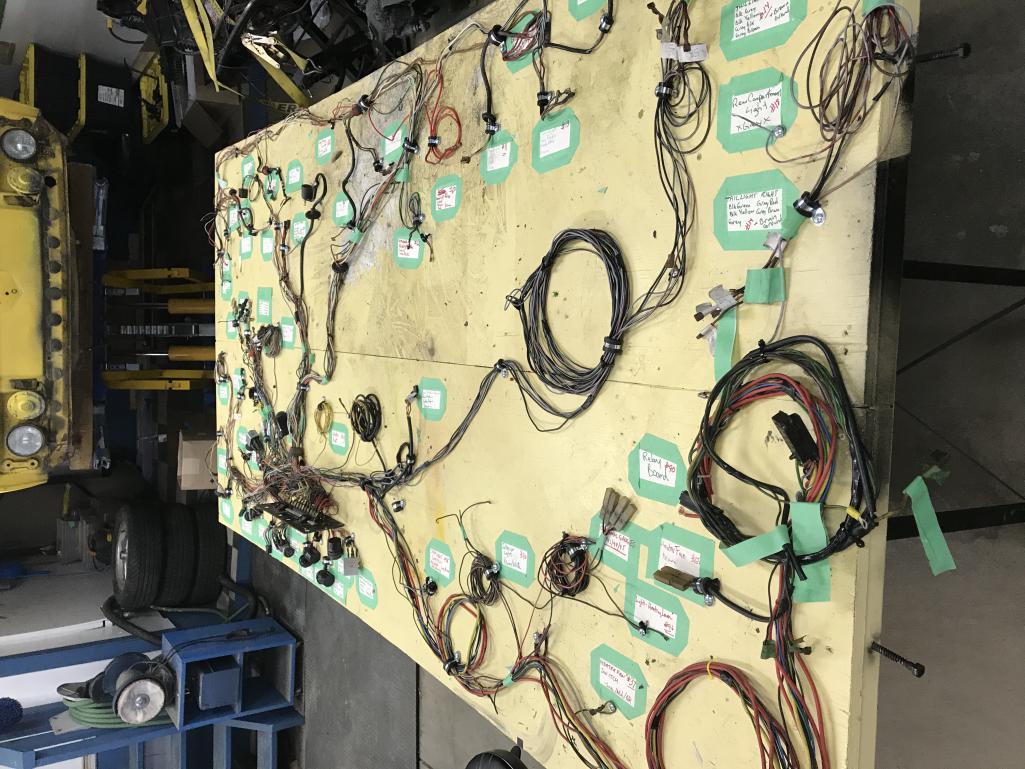 |
| Tdskip |
 Jan 9 2020, 11:32 AM Jan 9 2020, 11:32 AM
Post
#34
|
|
Advanced Member     Group: Members Posts: 3,748 Joined: 1-December 17 From: soCal Member No.: 21,666 Region Association: None 
|
|
| IronHillRestorations |
 Jan 9 2020, 11:53 AM Jan 9 2020, 11:53 AM
Post
#35
|
|
I. I. R. C.      Group: Members Posts: 6,905 Joined: 18-March 03 From: West TN Member No.: 439 Region Association: None 
|
I use black PVC jacketing on my engine harnesses, and I crimp and solder the terminals on both ends (PRN), taking explicit care just to solder the terminal ends. I also use some dual wall heat shrink, and very limited PVC tape
Pretty much all of my engine harnesses are made to spec using factory wire coding, with a couple exceptions due to wire availability. Using too small of a gauge wire is trouble, and too heavy of a gauge will make the wire bundle larger with can be a problem |
| jd74914 |
 Jan 9 2020, 12:46 PM Jan 9 2020, 12:46 PM
Post
#36
|
|
Its alive     Group: Members Posts: 4,864 Joined: 16-February 04 From: CT Member No.: 1,659 Region Association: North East States |
HOLY COW these are nice to use. Thanks for the encouragement gentlemen. Yep, once you go to ratcheting crimpers with the appropriate dies you never go back. And your die set continuously increases in size. (IMG:style_emoticons/default/laugh.gif) Even a budget-friendly model like you have is worlds above the ubiquitous cheap pliers-type crimper. If you want to really have fun start pinning connectors with machined pins/sockets (see Deutsch DT or HDP20 series for relatively budget friendly stuff) with a HDT-48-00 crimper or similar with turret and depth stops. (IMG:style_emoticons/default/drooley.gif) |
| Al Meredith |
 Jan 9 2020, 03:14 PM Jan 9 2020, 03:14 PM
Post
#37
|
|
Senior Member    Group: Members Posts: 981 Joined: 4-November 04 From: Atlanta, ga Member No.: 3,061 |
We Probably don't need one more 2 cents but, I was an electrician on Navy Jets back about 50 years ago and we always used crimp fittings for repairs . Of course we had the proper crimpers . only used solder on "cannon" plugs , but they were then "potted" to compensate for vibration.
|
| bbrock |
 Jan 9 2020, 03:45 PM Jan 9 2020, 03:45 PM
Post
#38
|
|
914 Guru      Group: Members Posts: 5,269 Joined: 17-February 17 From: Montana Member No.: 20,845 Region Association: Rocky Mountains 
|
and too heavy of a gauge will make the wire bundle larger with can be a problem Combining this with the important advice earlier to use only quality GXL or TXL automotive wire... If you do need or want to bump up a wire size, using TXL which has a thinner wall but same temperature and insulation rating as GXL can allow you to sneak in a slightly heavier gauge wire while keeping the bundle size manageable. |
| Larmo63 |
 Jan 9 2020, 09:01 PM Jan 9 2020, 09:01 PM
Post
#39
|
|
Advanced Member     Group: Members Posts: 4,267 Joined: 3-March 14 From: San Clemente, Ca Member No.: 17,068 Region Association: Southern California |
Hold my beer.........
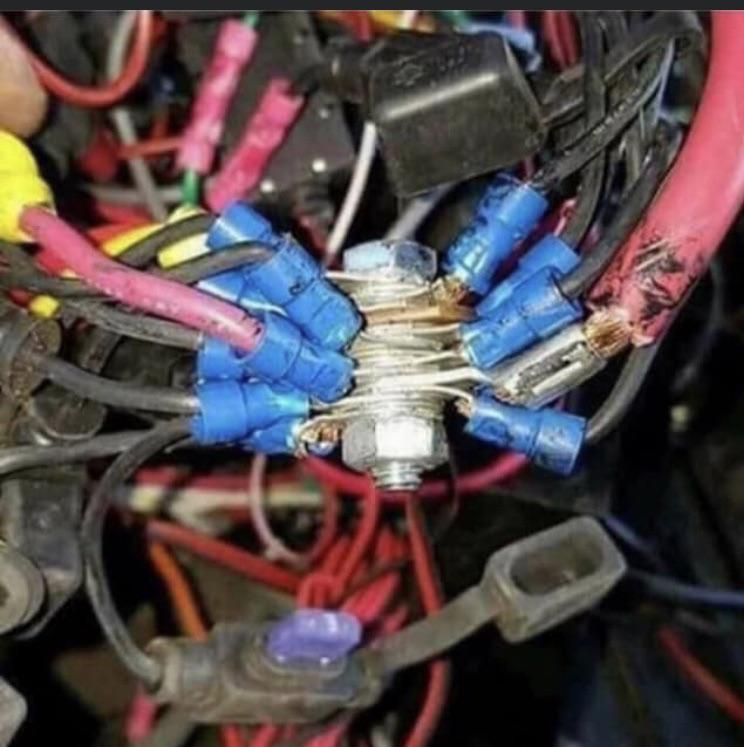 |
| gereed75 |
 Jan 10 2020, 08:02 AM Jan 10 2020, 08:02 AM
Post
#40
|
|
Senior Member    Group: Members Posts: 1,412 Joined: 19-March 13 From: Pittsburgh PA Member No.: 15,674 Region Association: North East States 
|
Don’t start with the substandard examples - I just spent about 6 hours removing a “professionally” installed remote start/security system from my son’s Toyota forerunner. Looked like an alien brain had integrated itself into the wiring harness with electrical tape, wrap ties and twisted wire “splices”. It sucked the reliability right out of the machine!
|
  |
1 User(s) are reading this topic (1 Guests and 0 Anonymous Users)
0 Members:

|
Lo-Fi Version | Time is now: 10th January 2026 - 12:11 AM |
Invision Power Board
v9.1.4 © 2026 IPS, Inc.









